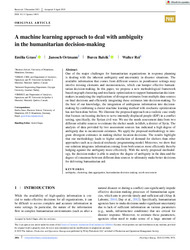A machine learning approach to deal with ambiguity in the humanitarian decision-making
| dc.contributor.author | Grass, E. | |
| dc.contributor.author | Ortmann, J. | |
| dc.contributor.author | Koyuncu, Burcu Balçık | |
| dc.contributor.author | Rei, W. | |
| dc.date.accessioned | 2023-11-01T09:58:15Z | |
| dc.date.available | 2023-11-01T09:58:15Z | |
| dc.date.issued | 2023-09 | |
| dc.identifier.issn | 1059-1478 | en_US |
| dc.identifier.uri | http://hdl.handle.net/10679/8912 | |
| dc.identifier.uri | https://onlinelibrary.wiley.com/doi/10.1111/poms.14018 | |
| dc.description.abstract | One of the major challenges for humanitarian organizations in response planning is dealing with the inherent ambiguity and uncertainty in disaster situations. The available information that comes from different sources in postdisaster settings may involve missing elements and inconsistencies, which can hamper effective humanitarian decision-making. In this paper, we propose a new methodological framework based on graph clustering and stochastic optimization to support humanitarian decision-makers in analyzing the implications of divergent estimates from multiple data sources on final decisions and efficiently integrating these estimates into decision-making. To the best of our knowledge, the integration of ambiguous information into decision-making by combining a cluster machine learning method with stochastic optimization has not been done before. We illustrate the proposed approach on a realistic case study that focuses on locating shelters to serve internally displaced people (IDP) in a conflict setting, specifically, the Syrian civil war. We use the needs assessment data from two different reliable sources to estimate the shelter needs in Idleb, a district of Syria. The analysis of data provided by two assessment sources has indicated a high degree of ambiguity due to inconsistent estimates. We apply the proposed methodology to integrate divergent estimates in making shelter location decisions. The results highlight that our methodology leads to higher satisfaction of demand for shelters than other approaches such as a classical stochastic programming model. Moreover, we show that our solution integrates information coming from both sources more efficiently thereby hedging against the ambiguity more effectively. With the newly proposed methodology, the decision-maker is able to analyze the degree of ambiguity in the data and the degree of consensus between different data sources to ultimately make better decisions for delivering humanitarian aid. | en_US |
| dc.language.iso | eng | en_US |
| dc.publisher | Wiley | en_US |
| dc.relation.ispartof | Production and Operations Management | |
| dc.rights | openAccess | |
| dc.rights | Attribution-NonCommercial-NoDerivs 4.0 International | |
| dc.rights.uri | https://creativecommons.org/licenses/by-nc-nd/4.0/ | |
| dc.title | A machine learning approach to deal with ambiguity in the humanitarian decision-making | en_US |
| dc.type | Article | en_US |
| dc.description.version | Publisher version | en_US |
| dc.peerreviewed | yes | en_US |
| dc.publicationstatus | Published | en_US |
| dc.contributor.department | Özyeğin University | |
| dc.contributor.authorID | (ORCID 0000-0002-3575-1846 & YÖK ID 24250) Balçık, Burcu | |
| dc.contributor.ozuauthor | Koyuncu, Burcu Balçık | |
| dc.identifier.volume | 32 | en_US |
| dc.identifier.issue | 9 | en_US |
| dc.identifier.startpage | 2956 | en_US |
| dc.identifier.endpage | 2974 | en_US |
| dc.identifier.wos | WOS:000983954000001 | |
| dc.identifier.doi | 10.1111/poms.14018 | en_US |
| dc.subject.keywords | Ambiguity | en_US |
| dc.subject.keywords | Clustering | en_US |
| dc.subject.keywords | Data aggregation | en_US |
| dc.subject.keywords | Humanitarian decision-making | en_US |
| dc.subject.keywords | Needs assessment | en_US |
| dc.identifier.scopus | SCOPUS:2-s2.0-85158837965 | |
| dc.relation.publicationcategory | Article - International Refereed Journal - Institutional Academic Staff |
Files in this item
This item appears in the following Collection(s)
Share this page




